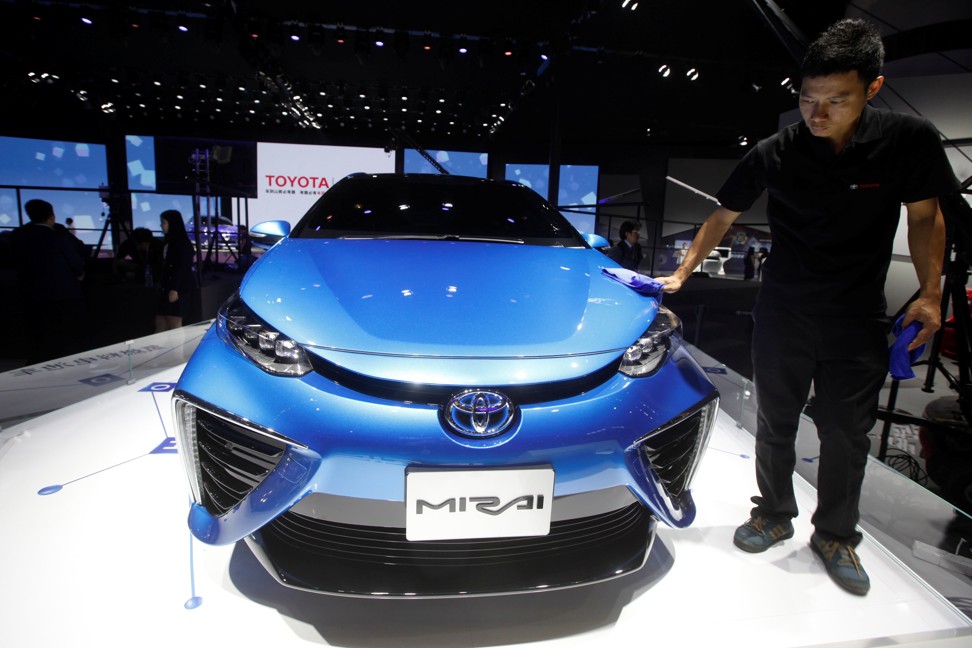
China sets sight on leapfrogging US and Japan in fuel-cell vehicles with subsidies for buyers and incentives for charging stations
- Buyers in 17 provinces will get subsidies of up to 160,000 yuan per fuel-cell vehicle this year while local authorities in 10 cities will hand out incentives of up to 4 million yuan toward the construction of every refuelling station
- The Chinese government is aiming to put a million fuel-cell vehicles on the roads by 2030, from 50,000 in 2025 and last year’s 1,791 units, more ambitious than plans outlined by Japan or in the US state of California
China’s government has set its sight on fuel-cell vehicles as the next growth engine in the world’s largest automobile market, as it aims to catch up with the United States and Japan in cutting emissions and taking the next giant leap in technology.
Buyers in 17 Chinese provinces will get subsidies of between 128,000 yuan and 160,000 yuan (US$22,000) per fuel-cell passenger car this year, while commercial vans and trucks get between 192,000 yuan and 400,000 yuan each, according to the Ministry of Finance. Local authorities in 10 cities have announced that they would hand out incentives of between 2 million yuan and 4 million yuan toward the construction of every refuelling station, following an April edict by China’s cabinet, according to an August report by Citic Securities.
The incentives form part of China’s plan to leapfrog the US and Japan in automotive technology, using the advantage of a market that sells more vehicles than any other nation on earth. The world’s number of fuel-cell vehicles (FCVs) jumped 80 per cent to 12,900 units last year, with 46 per cent of them in the US, followed by 23 per cent in Japan and 14 per cent in China, according to the International Energy Agency.
The Chinese government is aiming to put a million fuel-cell vehicles on the roads by 2030, from 50,000 in 2025 and last year’s 1,791 units, more ambitious than the plans outlined by Japan or in the US state of California. Still, China’s ambitious goal pales in comparison to South Korea, which aims to have 1.8 million hydrogen-powered vehicles in service by 2030, with 80,000 units in 2023.
Hydrogen fuel cells could meet 18 per cent of global energy demand by 2050, creating a US$2.5 trillion market for hydrogen and fuel cell equipment, and contributing a fifth of the carbon emission abatement needed to limit global warming to 2 degrees Celsius, projected the Hydrogen Council, an international body backed by 60 firms.
“FCVs are currently at a similar stage of development as electric vehicles in 2013 and 2014, when the entire supply chain saw explosive growth thanks to a top-down government policymaking process,” TF Securities’ said in a note in April.
Interactive Infographics: Electric vehicles and their role in Made in China 2025 master plan
The Chinese government’s policies will help FCVs compete with electric vehicles that run on batteries, especially for public transit and heavy-duty vehicles where longer driving range and shorter refuelling time make fuel-cell vehicles the better zero-emission alternative to automobiles that run on internal combustion engines. Fuel cells produce electricity and water after combining hydrogen and air.
“When you think about a bus – do you want it to carry more batteries or passengers?” said Alfred Wong, the Asia-Pacific managing director of Canada-based fuel cell technology developer Ballard Power Systems, noting that electric vehicles faced a disadvantage compared with FCVs in public transit.
The FCVs industry is aiming to cut costs by 50 per cent in the next three to five years, based on announced global government ambitions and policy support, he added.

China is aiming to halve the cost of fuel cell systems to 4,000 yuan per kilowatt by 2025 from last year, according to a white paper on fuel cell industry development published by China Hydrogen Alliance late June.
“Once we get the cost of heavy-duty vehicles down, we can address the lighter vehicles market, starting with the vehicles the ride-sharing applications enabled for smartphones, that require long driving range and short refuelling time,” he said.
A Toyota Mirai FCV can run 500 kilometres after five minutes of refuelling, compared with a charging time of between 30 minutes and up to nine hours for a range of between 150 to 300 kilometres for many electric vehicles.

